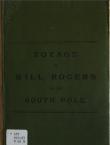AustLit
The material on this page is available to AustLit subscribers. If you are a subscriber or are from a subscribing organisation, please log in to gain full access. To explore options for subscribing to this unique teaching, research, and publishing resource for Australian culture and storytelling, please contact us or find out more.
Latest Issues
AbstractHistoryArchive Description
'In Christopher Spotswood's late nineteenth-century utopis, Voyage of Will Rogers to the South Pole, the temperate land of Bencolo harbours plentiful precious metals, and Rogers happily pockets the five pounds of gold presented to him by his Antarctic friends.'
Source: Leane, Elizabeth. South Pole: Nature and Culture. The University of Chicago Press, 2016.
Notes
-
This work has been digitised by the Reason in Revolt project.
Publication Details of Only Known VersionEarliest 2 Known Versions of
Works about this Work
-
'A Place of Ideals in Conflict' : Images of Antarctica in Australian Literature
2007
single work
criticism
— Appears in: The Littoral Zone : Australian Contexts and Their Writers 2007; (p. 261-290) This chapter examines Australian literature (poetry, fiction, and plays) dealing with Antarctica, focussing on each text's engagement with the Antarctic environment and the debates surrounding it. Beginning with two late nineteenth-century Antarctic utopias, the survey moves through the work of well-known writers such as Douglas Stewart and Thomas Keneally in the mid-century to more recent writing by Dorothy Porter, Les Murray, Caroline Caddy, and others. Less familiar material, such as poetry by Antarctic expeditioners themselves, is also discussed. The essay traces a rough progression in Australian representation of the far southern environment, from an initial utopian approach to an emphasis on its stark, 'timeless' icescape as a minimalist backdrop for human dramas to an appreciation of its changeability, complexity and fragility. (from The Littoral Zone) -
Lost and Found Cities and Peoples : Polar Regions
2001
single work
review
— Appears in: Notes on Australian Science Fiction 2001; (p. 87-88)
— Review of At the South Pole 1870 single work novel ; Neuroomia : A New Continent : A Manuscript Delivered by the Deep 1894 single work novel ; Valdmer the Viking : A Romance of the Eleventh Century by Sea and Land 1893 single work novel ; Voyage of Will Rogers to the South Pole 1888 single work novel ; Beyond the Ice : Being a Story of the Newly Discovered Region Round the North Pole 1894 single work novel
-
Lost and Found Cities and Peoples : Polar Regions
2001
single work
review
— Appears in: Notes on Australian Science Fiction 2001; (p. 87-88)
— Review of At the South Pole 1870 single work novel ; Neuroomia : A New Continent : A Manuscript Delivered by the Deep 1894 single work novel ; Valdmer the Viking : A Romance of the Eleventh Century by Sea and Land 1893 single work novel ; Voyage of Will Rogers to the South Pole 1888 single work novel ; Beyond the Ice : Being a Story of the Newly Discovered Region Round the North Pole 1894 single work novel -
'A Place of Ideals in Conflict' : Images of Antarctica in Australian Literature
2007
single work
criticism
— Appears in: The Littoral Zone : Australian Contexts and Their Writers 2007; (p. 261-290) This chapter examines Australian literature (poetry, fiction, and plays) dealing with Antarctica, focussing on each text's engagement with the Antarctic environment and the debates surrounding it. Beginning with two late nineteenth-century Antarctic utopias, the survey moves through the work of well-known writers such as Douglas Stewart and Thomas Keneally in the mid-century to more recent writing by Dorothy Porter, Les Murray, Caroline Caddy, and others. Less familiar material, such as poetry by Antarctic expeditioners themselves, is also discussed. The essay traces a rough progression in Australian representation of the far southern environment, from an initial utopian approach to an emphasis on its stark, 'timeless' icescape as a minimalist backdrop for human dramas to an appreciation of its changeability, complexity and fragility. (from The Littoral Zone)
Last amended 17 Mar 2016 15:34:28
Export this record




